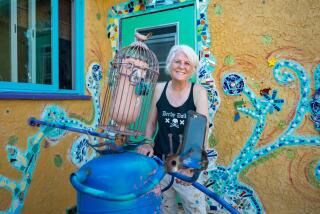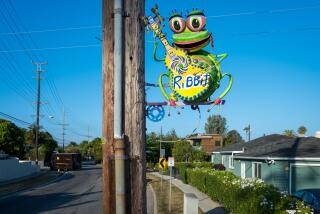L.A. homeowners fight the glare of digital billboards
The view from Betty Kermanianâs Westwood-area backyard changes every few seconds.
Through the leafy limbs of a tree in front of her house, the stars of âSherlock Holmesâ -- Robert Downey Jr. and Jude Law -- peer down from a luminescent Clear Channel digital billboard that towers over nearby Santa Monica Boulevard. Seconds later, Kiefer Sutherland flashes his gun in an ad for â24.â Also in the mix are four iterations of midriff-baring vixens selling an H&M line of lacy black bras and silk kimonos.
Living with the sign over the last two years, Kermanian has routinely drawn the shades in her front rooms. She even moved three maples from the backyard to a spot outside her dining room window to block the flickering pink and purple beams that change the color of her walls.
âItâs so tacky, it looks like itâs Las Vegas,â Kermanian said on a recent evening as she watched the ads rotate from her yard. When she entertains guests, âthey just canât believe it,â she said. âYouâre sitting in a nice residential area and thereâs this digital thing changing colors all the time.â
Kermanian is not alone in her disquiet about digital billboards. A bright Disneyland billboard off the 101 near Universal Studios has angered some Hollywood Hills residents, who say it has spoiled their views and cast an aqua glow over trees and homes. And Angelenos in Venice and Silver Lake have voiced similar objections about signs in their neighborhoods. With a recent court ruling, they now see an opportunity to pressure the Los Angeles City Council to pull the plug on at least the signs that disrupt their peace and quiet.
The 92 digital signs began popping up several years ago after Los Angeles struck a deal with two billboard companies, Clear Channel Outdoor and CBS Outdoor, which had sued the city over its earlier sign regulations. The 2006 agreement, negotiated by former City Atty. Rocky Delgadillo, allowed Clear Channel Outdoor and CBS Outdoor to modernize up to 840 billboards in exchange for removing 98 -- 3% of their inventory. The City Council approved the deal, but a number of council members have said they did not grasp the effect it would have on some of their constituents.
Last year billboard competitor Summit Media sued the city, alleging that the 2006 settlement in effect exempted the two companies from city zoning laws that other firms were required to follow
In November, Superior Court Judge Terry A. Green ruled in favor of Summit and invalidated the agreement.
But Green said it was up to the city to determine whether to revoke the permits for the Clear Channel and CBS digital billboards. Councilmen Paul Koretz and Bill Rosendahl immediately called for converting all of the brightly lit signs back to traditional billboards, while council President Eric Garcetti and Councilman Ed Reyes proposed studying whether the signs should be modified or demolished. But CBS and Clear Channel appealed the ruling -- putting a stay on Greenâs order. Meanwhile, council members have asked city officials to evaluate their legal options.
At public hearings, business groups have argued that reneging on the 2006 settlement would send the chilling message that no one can rely on city commitments. Representatives from billboard companies have noted that the modernized signs represent just a fraction of the thousands of billboards across Los Angeles.
In January, city officials began a block-by-block inventory, and so far they have counted 6,200 billboard structures (with a total of more than 9,000 sign faces -- some structures have ads on both front and back. Of the 92 digital signs that are operational, 13 belong to CBS Outdoor and 79 to Clear Channel Outdoor, city records show.
Though residents sent several dozen e-mails to council members urging them to take down the digital billboards after Greenâs ruling, a building and safety official said his department received just half a dozen formal requests to test the brightness of digital billboards. In all of them, the signs met the cityâs lighting standards.
Ryan Brooks, vice president of government affairs at CBS Outdoor, said his company has received a small number of sign complaints. âWe were very cautious and deliberate in where we chose to place our signs,â Brooks said. âWe spent a lot of time to make sure we didnât create any problems.â
Clear Channel Outdoor declined to comment, citing litigation. But Laura W. Brill, an attorney for Clear Channel and CBS, told council members in a Nov. 16 letter that âcontrary to the strident complaints of a small but vocal group of neighborhood activists . . . the majority of Los Angeles residents appreciate the special qualities of digital signs.â
Some residents scoff at that notion and have taken matters into their own hands.
In Westwood, several homeowner groups joined forces with the Coalition to Ban Billboard Blight. They have challenged the validity of the permits for three digital billboard displays -- two on South Westwood Boulevard and one on West Santa Monica Boulevard, near Kermanianâs home -- in an effort to get them taken down.
Although residents are concerned about preserving the character of their neighborhoods, Barbara Broide, president of the Westwood South of Santa Monica Blvd. Homeowners Assn., said her group also took up the fight because members worry that the digital signs have lowered property values. âIf you had a choice of buying a home, would you buy a home that had one of these things in your backyard?â Broide said.
The groups waited more than six months before a zoning administrator heard the cases and another five months for decisions. The administrator ruled for the homeowners groups on the two Westwood Boulevard signs.
In the decisions, she wrote that before the city issued the permits, a planning official should have determined whether the modernized billboards violated two neighborhood plans barring signs that flash, move or have the appearance of movement. Clear Channel and CBS are appealing those decisions.
In the third case, members of the Comstock Hills Homeowners Assn. argued that the placement of the digital sign on Santa Monica Boulevard was improper because the roadway is a designated scenic highway.
And they marshaled testimony from residents unhappy with the brightness and the sound created by the billboards. Among them was Jean Bushnell, who bought a white-noise machine to drown out the digital signâs cooling fans. Bushnell likens the fansâ noise in the summer months to the drone of an airplane or the rumble of a truck engine.
The zoning administrator did not find problems with the permit, a decision the groups are appealing.
In the Hollywood Hills, residents unhappy with the Disneyland billboard on Barham Boulevard, which is owned by CBS Outdoor, turned to their neighborhood council president for help.
Judy Marlin, who bought her home some 30 years ago largely because of the mountain view from its bank of windows, said the appearance of the sign shocked her and many neighbors. âI looked out and there was what looked like a gigantic television screen in the middle of the view,â Marlin said. âWe just canât believe we went to bed one night and there was this sign and we had nothing to say about it.â
Marlin and others relied on the personal connections of Anastasia Mann, president of the Hollywood Hills West Neighborhood Council, who persuaded a Disney executive to have the sign turned off between midnight and sunrise.
Garcetti, the City Council president, has proposed that over the next few weeks, officials conduct a series of meetings with the sign companies to see if some of the digital displays can be moved out of residential neighborhoods.
And Councilman Tom LaBonge, who represents the area that has the Disneyland billboard, said he wants to see that sign unplugged. âIt would be great if we could turn back the clock,â he said.
More to Read
Inside the business of entertainment
The Wide Shot brings you news, analysis and insights on everything from streaming wars to production â and what it all means for the future.
You may occasionally receive promotional content from the Los Angeles Times.











